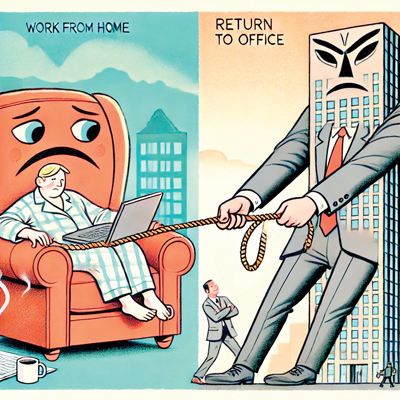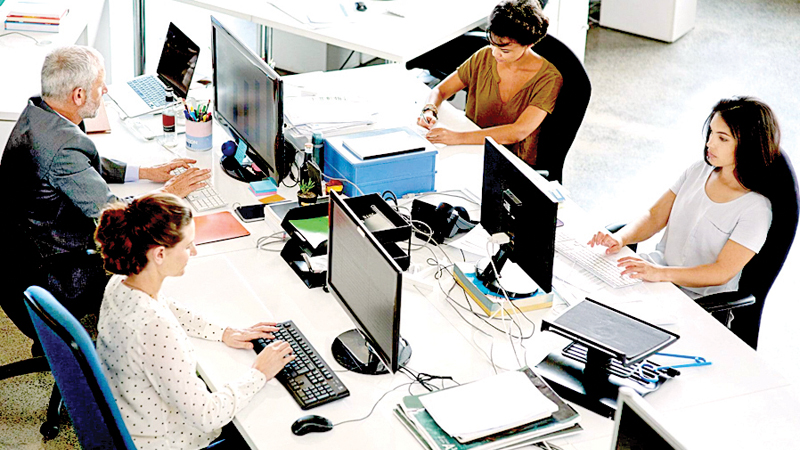 The year 2024 ended with no clear winner in sight in the Great Debate – Work From Home (WFH) vs Return To Office (RTO). In fact, I am typing this article in a WFH setting on New Year’s Day, with no disturbance from office telephone calls, colleagues or other distractions.
The year 2024 ended with no clear winner in sight in the Great Debate – Work From Home (WFH) vs Return To Office (RTO). In fact, I am typing this article in a WFH setting on New Year’s Day, with no disturbance from office telephone calls, colleagues or other distractions.
The concept of WFH gained prominence with the advent of the Covid-19 pandemic, when Governments around the world imposed strict lockdowns and travel restrictions. Suddenly, it was no longer possible to travel to the office to work. Journalism was perhaps the first line of work to reap the benefits of WFH.
Indeed, journalists can do their job from anywhere in the world thanks to advances in Information Technology (IT), so we leapt into action virtually from Day One of the lockdown, producing the Daily News (where I was Chief Editor at the time) entirely from home. All the reporters and outside writers emailed their copies to me and the News/Features Editors, while the page designers did the pages from home based on the instructions and inputs of the sub editors, who were also at home.
Initially we did an e-paper with just four pages, but as the lockdown extended, the page count was increased to the normal 40 pages. This was a real-time collaborative effort, with editorial and management meetings via Google Meet and Zoom (a company and service that rose to prominence during the pandemic) and PDF files shared by email.
Skeleton crew
Fortunately, almost every staff member had a laptop with 4G access, which made things easier. The e-paper was a roaring success by all accounts and indeed, helped our publisher the Associated Newspapers of Ceylon Limited (ANCL) to migrate to a digital subscription model once the pandemic receded.
But not every job lends itself to the WFH model. Even in the case of producing a newspaper through WFH, a skeleton crew had to be stationed in the office (at some risk to their health), as certain pre-press actions could not be done solely from home. Moreover, there were a few days during the pandemic that the paper was printed due to certain advertising obligations, which essentially meant that press operators had to be physically present in the office.
Just think of the many jobs that cannot really be done from home. Health professionals and workers had to report to hospitals to look after Covid-19 and other patients. Indeed, some of them contracted the disease and died. However, telemedicine is becoming increasingly popular and available, with doctors being able to diagnose diseases remotely with the help of Artificial Intelligence (AI).
But WFH would be completely impractical in the case of sanitary, utility, hospitality, transport, logistics, security, Police and Armed Forces, pharmacy and many other sectors. Moreover, unlike print journalists who could produce a newspaper from home, most radio and TV journalists and producers had to go to their offices amid the pandemic as such content cannot be produced without using proper studio-based professional broadcasting equipment. The same applied to our photographers, who went out into the field clad in Personal Protective Equipment (PPE).
Substantial saving
 But for those sectors which could accommodate WFH, the advantages far outweigh the disadvantages. Research has shown that WFH actually makes employees more productive and less conscious of the passing time. From my own experience, there were many days that our team worked for 12 hours or more, which would not strictly happen in an office environment. In the case of some jobs, the employee can set his or own WFH schedule, thereby creating a better Work-Life balance. Workers can also set up their own workspace at home according to their preferences. WFH also obviates the need for transport and office clothing, both of which are significant expenses.
But for those sectors which could accommodate WFH, the advantages far outweigh the disadvantages. Research has shown that WFH actually makes employees more productive and less conscious of the passing time. From my own experience, there were many days that our team worked for 12 hours or more, which would not strictly happen in an office environment. In the case of some jobs, the employee can set his or own WFH schedule, thereby creating a better Work-Life balance. Workers can also set up their own workspace at home according to their preferences. WFH also obviates the need for transport and office clothing, both of which are significant expenses.
One can also reduce the expenditure on food as outside food is generally more expensive than food cooked at home. WFH can also be done from anywhere in the world – there is no need to stick to “home” in the real sense of the word. WFH is good for the environment too, based on the prevention of pollution from transport alone. WFH can also help companies to cut down on their phone, power and water bills when fewer employees report to office. This could lead to a substantial saving that is reflected in year-end accounts.
Lest one think that employers cannot monitor employees who WFH, there are many remote software programs that keep a tab on their online presence and working hours. WFH is not a free pass to spend your time as you please.
Limitations and shortcomings
WFH is not without its limitations and shortcomings. First, an employee needs to be properly equipped for WFH. Desktop and laptop computers are expensive, not to mention peripherals such as headsets, software, work furniture, printers and scanners. However, not every WFH job needs a computer per se – for example, a customer service agent can answer telephone calls without using a computer. Having a computer alone is not adequate – there should be fast Internet access with sufficient bandwidth for video calls and meetings. Data charges can pile up, sometimes exceeding the allowance granted by employers.
It is also essential to ensure that one is free from distractions such as noisy children and pets and also intrusions into the workspace by other family members. There are many instances where babies, pets and family members have photo bombed Zoom meetings, sometimes with funny or even disastrous results.
The mobile phone may also prove to be a distraction, if too many personal or even work-related calls are received. One must also suppress the temptation to watch cat videos and songs on YouTube whilst WFH, quite apart from the newsfeed on Facebook and X. WFH can also lead to higher electricity and telephone charges, which may or may not be paid by the employer.
Most people hate office meetings, but they are even worse online. In a physical office meeting, one can interpret body language, gestures, furtive glances, things that are left unsaid and other subtle nuances. None of this is really possible in a Zoom/Meet/Teams meeting, as some participants turn off the video camera in any case. It then becomes more difficult to interpret what they really mean or to read between the lines. In other words, physical office meetings are much more productive than virtual ones. Besides, the participants also get cake and tea/coffee on the house at office.
The whole WFH/RTO debate, spurred by RTO mandates from global companies such as Amazon, Dell, Meta (Parent company of Facebook), Goldman Sachs and Disney, has shifted the focus on to the advantages and disadvantages of working physically from the office. The RTO edict naturally elicited strong reactions from employees who had got used to WFH.
Amazon almost had to eat its words after discovering that it did not have the space to accommodate all the staffers in its offices – a factor that employers must bear in mind before issuing an RTO order. In Sri Lanka, almost all companies that shifted to WFH have now reverted to RTO, without much protest from employees.
Best advantage
The best advantage of office work is that one gets to meet and interact with superiors and fellow employees face to face, not through a screen. This fosters a spirit of teamwork and collaboration that may not be possible through WFH, even though real-time virtual collaboration is possible on some platforms. Problem- solving is also easier at the office, as all the personnel are in one place.
Training of new personnel can usually only be done in an office setting, as it would be an extremely difficult process to undertake completely online. Being in the office allows for more opportunities for mentorship, training, and professional development.
Employees can learn from and share ideas with their colleagues and supervisors through direct interactions and observations.
The office environment also provides opportunities for networking with colleagues, clients, and other professionals. Workers can also access more resources in an office, from advanced computers to photocopiers. Documentation is also easier at the office since most paperwork requires a physical signature, though software programs that facilitate online signatures are becoming common. Best of all, the office can be fun, with shared lunches and tea and the occasional joke session that shatters the boredom and monotony.
Some office assignments also require workers to go out to the field, which gives them an opportunity to literally get some fresh air.
WFH can sometimes lead to feelings of isolation and loneliness. In fact, many cases of depression were reported from WFH workers during the pandemic, especially among those who were living alone. This led counsellers to suggest getting a pet (dog, cat or bird) which would give them love and companionship. On the other hand, RTO allows for social interactions and a sense of belonging to one entity or company, which can improve overall morale and job satisfaction. As an added bonus, you may even find your life partner from the office, which would be “virtually” impossible.
Some companies have given up both extremes and opted for a middle-of-the-road “hybrid” alternative that mixes the best elements of WFH and RTO. This allows workers to choose the days of WFH and RTO, say, two days WFH and three days RTO. In some countries, this has been coupled with a reduced work week overall – 30 or 35 hours a week instead of the present 40 or more hours. Research and real office experience suggest that the WFH-RTO hybrid is the most productive path, with employees finding an almost perfect Work-Life balance and employers getting their money’s worth in the form of more productivity.
Some companies have even allowed their employees to become “Digital Nomads” exploring foreign lands and working “on the fly”. It is clear that the nature of work itself is changing in this age of AI and Internet of Things. One does not have to be tethered to the office or home to work – just work from wherever life takes you.






